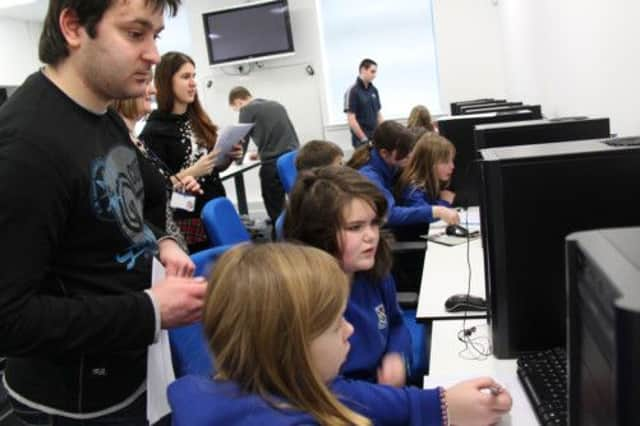Euan McColm: Faith schools can teach the rest of


In fact, they were “non-denominational” but we called them “Proddie” to differentiate them from the ones we called “Fenian”.
The schools I attended were, in chronological order, in an affluent Renfrewshire village, a deprived Lanarkshire one, and a comfortable Glasgow suburb. At each one, among our avowed enemies were kids from the nearest Catholic school.
Advertisement
Hide AdAdvertisement
Hide AdSocial background seemed to make no difference to the degree to which some of my classmates despised children who went to different schools based on the fact they attended a different church. Or, more accurately, went to church at all during the 70s and 80s.
I’m struggling today to remember any occasion when my Proddie classmates and I clashed with any Fenians, but I recall, particularly from my time in Lanarkshire, some grim playground folklore: historic pitched battles with kids from across town; doings at bus stops; revenge attacks outside Spar. Whether these incidents happened or not, the stories were vivid with splattered blood and crunched bone. And I knew that word “Fenian” by the time I was six.
By some stroke of good luck, I was fully repulsed by this hateful division by adolescence. Since then, though, it’s far from the top of my for-others-to-do list, I’ve been instinctively against separate faith schools. Mine is the far from uncommon question: “How can kids get along if we separate them?”
Professor AC Grayling – the philosopher, whose recently published book The God Argument advances an argument for humanism as a replacement for religious faith – made his more passionate opposition to faith schools plain during a meeting at Holyrood last week. Grayling told representatives of secular and humanist groups: “The argument against faith-based schools can be summed up in two words – ‘Northern Ireland’. Or perhaps one word – ‘Glasgow’.” Grayling’s point that if you divide kids along religious lines you risk creating adults divided along religious lines seems hard to argue around.
But agreeing with Grayling’s sentiment is one thing – agreeing that the abolition of faith schools is possible is quite another. Shortly after he made his remarks, a Catholic Church spokesman declared them ill-informed and invoked the Universal Declaration of Human Rights. It was a tough, swift response; a speckle of what politicians might expect if they actually proposed the abolition of state-funded faith education.
There’s no real political will to do that, anyway. Faith education is one of the sticky subjects politicians choose, probably wisely, to avoid. Around half of Scots may be opposed to faith schools, but many of the other half feel quite strongly, indeed, that they’re a good thing.
It strikes me, though, that if we’re going to pay for faith – predominantly Roman Catholic – schools, we should explore whether there’s anything the broader education system can learn from them.
At first glance, faith schools might seem exclusive, but isn’t the reality different? Isn’t one of their most interesting aspects the diverse social mix of their pupil populations? They provide more fully comprehensive learning environments for kids than those enjoyed by most young Scots.
Advertisement
Hide AdAdvertisement
Hide AdFaith schools – 373 Catholic, three Episcopalian, and one Jewish – account for fewer than 15 per cent of the school estate. The majority of secondaries serve far narrower geographical communities than those served by faith schools.
Feeder primaries for faith secondaries are, necessarily, spread across a wider geographical area; kids from affluent homes and kids from deprived areas (and those in between) are far more likely to study alongside each other in a faith school than in a non-denominational one.
Parental obsession with performance tables has driven inequality between schools. Areas with the best performing secondaries are unaffordable to most. Poverty – already closely linked to poor educational achievement – acts as a barrier to kids getting to schools with the resources that might help them overcome their lives’ default-setting disadvantages.
Parents who can afford the local house prices send their children to secondaries populated almost exclusively by youngsters from similarly comfortable backgrounds. We’ve created little ghettoes of privilege, where, if you’ve quarter of a million to spend on a semi-detached, your teenagers can get the sort of education that matches those provided by some expensive private schools.
Could the Scottish Government take the example of faith schools to create a richer social mix in the non-denominational sector? In time, why not? Reconfiguring which feeder primaries serve existing secondaries would be messy: parental opposition, transport issues – it’s not hard to see where problems lurk. But when it comes to new secondaries, wouldn’t it be worth siting them in the optimum locations to create, through the mix of their feeder primaries, as diverse as possible a representation of society in their classrooms; kids from middle-class suburbs alongside kids from run-down estates? Couldn’t we reshape our schools to reflect, more accurately, the Scotland in which we live?
A parent’s desire to see a child receive the best education is hardly difficult to understand, but the best education shouldn’t come at the expense of learning about the real world.
AC Grayling’s point about faith schools might have chimed with many, but Scotland is nowhere near ready to have that debate. Look at last year’s illiberal Offensive Behaviour at Football Act, which effectively criminalises people for singing songs or displaying signs or even wearing T-shirts that others might find offensive, if you want to know how muddle-headed our current government is over the sectarianism issue. Scotland doesn’t seem able yet to discuss matters of differing beliefs without the charge of prejudice being thrown.
Though we’re making some progress – through education – in challenging sectarian behaviour, we don’t seem to be doing so much in challenging the greater problem of inequality of opportunity among Scots children. And that’s where faith schools – with their great social diversity – might have a lesson for the rest of us. «
Twitter: @euanmccolm